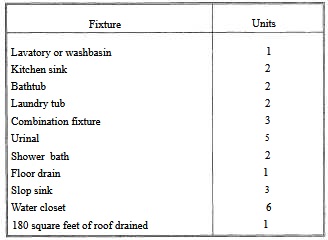CHAPTER 5 PLUMBING FIXTURES AND PLUMBING REPAIRS
LEARNING OBJECTIVE: Identify different plumbing fixtures; recognize procedures for rough-in measurements and methods of identifying problems; explain repair, maintenance, and troubleshooting of plumbing fixtures and accessories.
"Roughing-in," as applied to plumbing and pipe fitting, is a term used for the installation of concealed piping and fittings at the time a building is being constructed or remodeled. As the building nears completion, the final connection of the plumbing fixtures is made. Once construction is complete, continuous maintenance and repair will be necessary on the entire water and sewer systems. In this chapter, you will be introduced to various procedures and methods to install, maintain, and repair water and sewage systems. Use the information given here as a foundation on which to build a wider and broader knowledge of the Utilitiesman rating.
PLUMBING FIXTURES
LEARNING OBJECTIVE: Recognize rough-in measurements and types of fixtures and accessories.
Plumbing fixtures are the receptacles into which body wastes are placed before being discharged into the sanitary sewer. There are many types and styles of fixtures, some are general, while others have been adapted to meet special applications, such as for hospitals, prisons, and similar institutions. Many plumbing fixtures are constructed solely of vitreous China, iron, or porcelain-covered steel. Always be careful when handling, installing, or repairing fixtures. Military installations usually are planned to house large numbers of personnel, and the plumbing fixtures ordinarily are installed in batteries. The actual installation of a fixture is a hard-and-fast rule; either the manufacturer states how it is to be done or specifications state the so called "roughing-in" measurements of the fixture in question. Sometimes you may have to design and lay out a fixture or battery of fixtures. You must know what water supplies and stack sizes are needed and work these into your design.
Standard plumbing fixtures are individually tested and the amount of liquid waste that can be discharged through their outlet orifices in a given interval is measured. When we learned that the washbasin, one of the smaller fixtures, discharges 1 cubic foot of water per minute, we had the basis for the fixture unit system. One fixture unit of a known liquid discharges 1 cubic meter of water per minute or about 7 l/2 gallons. Even though 7 l/2 gallons is not shown in table 5-1, we chose that value to come up with an even meter. Try this one. How many flushings of a urinal equal five flushings of a water closet or toilet? Five or six? The fixture unit value for different plumbing fixtures is shown in table 5-1.
Each fixture is equipped, of course, with a waste pipe of sufficient capacity to carry off 'quickly and quietly all water supplied to it. A plumbing fixture must also be furnished with water at a rate of flow that will fill it within a reasonable time.
Table 5-1. - Plumbing Fixture Unit Values

